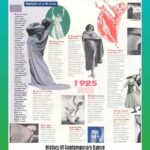Prepare to embark on a captivating journey through art history as we unveil the fascinating story of art timeline posters. These unique visual timelines offer a comprehensive overview of the evolution of artistic styles and movements, allowing us to trace the trajectory of art from its earliest forms to the contemporary masterpieces that grace galleries today. Join us as we explore the origins, significance, and impact of these remarkable creations in [Unveiling the History of Art Timeline Posters – A Journey Through Artistic Evolution].
Key Takeaways:
Art timeline posters offer a visual journey through the evolution of art history, allowing viewers to grasp the progression of artistic movements and styles across time.
The origins of art timeline posters can be traced back to the late 19th century, with early examples focusing on presenting a chronological overview of art history.
Art timeline posters have undergone significant developments over time, incorporating new technologies and expanding their scope to include a wider range of art forms and cultures.
The creation of art timeline posters involves meticulous research and collaboration among art historians, designers, and publishers to ensure accuracy and visual appeal.
Art timeline posters serve as valuable educational tools for students, educators, and art enthusiasts, providing a comprehensive visual reference for understanding the progression of artistic styles and movements.
Digital art timeline posters offer interactive features and customization options, enhancing the learning experience and catering to diverse interests.
Art timeline posters remain a popular and versatile resource for understanding the vast history of art, offering a concise yet informative overview of major artistic periods and movements.
History of Art Timeline Poster
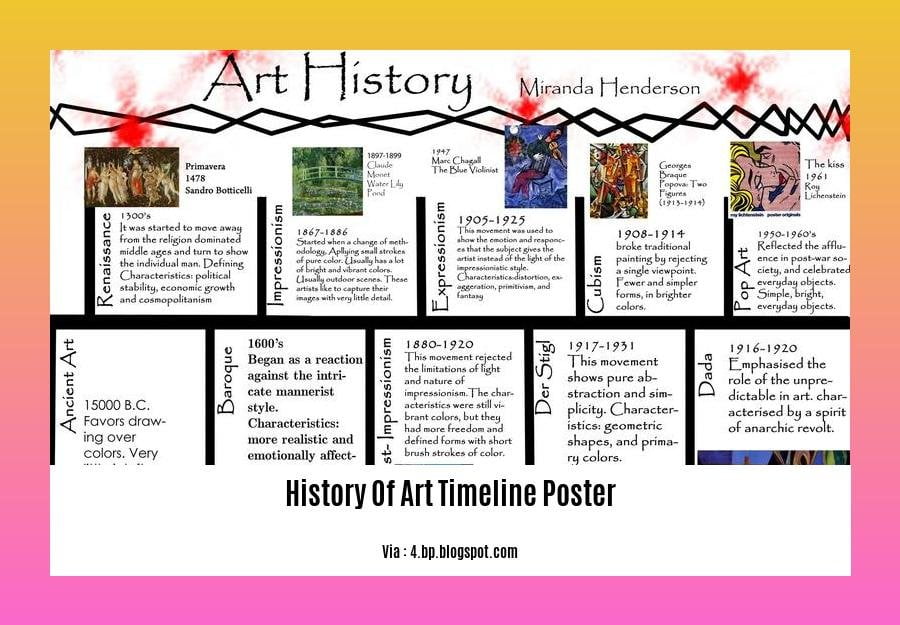
As an art aficionado, you may have stumbled upon the intriguing concept of an art timeline poster, a visual representation of art history’s vast expanse. These posters offer a glimpse into artistic evolution, showcasing renowned artworks from different periods and highlighting the evolution of styles and techniques.
The genesis of art timeline posters can be traced back to the late 19th century, when art historians and educators sought innovative methods to convey the complexity of art history to students. These posters provided a comprehensive overview of major artistic movements, from the Renaissance to Modernism, allowing students to grasp the chronological progression of art.
Today, art timeline posters remain an essential tool for art education, gracing the walls of classrooms, studios, and homes of art enthusiasts worldwide. They serve as visual guides, inviting viewers to embark on a journey through time, exploring the masterpieces that have shaped the art world.
Exploring the Evolution of Artistic Styles
Art timeline posters offer a unique perspective on the evolution of artistic styles. By juxtaposing works from different eras, viewers can discern the subtle shifts in artistic expression. For instance, comparing a Renaissance painting to an Impressionist masterpiece reveals the transition from detailed realism to a focus on light and atmosphere.
Understanding the Context of Art
Art timeline posters not only showcase artworks but also provide historical context. Each entry on the poster typically includes the artist’s name, artwork title, date of creation, and the artistic movement to which it belongs. This information helps viewers understand the influences and motivations behind each artwork and appreciate its significance within the broader context of art history.
Inspiring Creativity and Appreciation
Art timeline posters serve as a source of inspiration for artists and art enthusiasts alike. By viewing a diverse range of artworks, viewers may discover new artistic techniques, explore different perspectives, and gain a deeper appreciation for the creative process. This exposure to diverse artistic expressions can spark creativity and fuel artistic development.
Conclusion
Art timeline posters are invaluable tools for understanding and appreciating the vastness of art history. They provide a visual representation of artistic evolution, offering insights into the development of styles, techniques, and artistic movements. Whether you’re an art historian, student, or simply an art enthusiast, these posters offer a unique and engaging way to explore the world of art.
Dive into the fascinating evolution of Apple’s revolutionary journey with our comprehensive timeline, exploring the key milestones and innovations that shaped the history of Apple computers. Be prepared to be captivated by the transformative journey of this iconic tech giant.
Curious about the remarkable journey of Apple Inc.? Uncover the compelling story of its evolution through our meticulously crafted timeline, showcasing groundbreaking moments and strategic decisions that propelled the company to its current status as a global leader in technology and innovation. From humble beginnings to its position as a global powerhouse, explore the history of Apple Inc. and witness the passion and innovation that changed the world.
Step into the vibrant world of Bachata’s captivating history, a captivating dance form that ignited passion and rhythmic energy in the hearts of millions. Discover its captivating origins, its evolution into a global phenomenon, and the iconic figures who shaped its legacy. Embark on a musical journey through the history of Bachata and immerse yourself in its mesmerizing beats and infectious rhythms.
Educational Influence: The Role of Art Timeline Posters in Schools and Museums
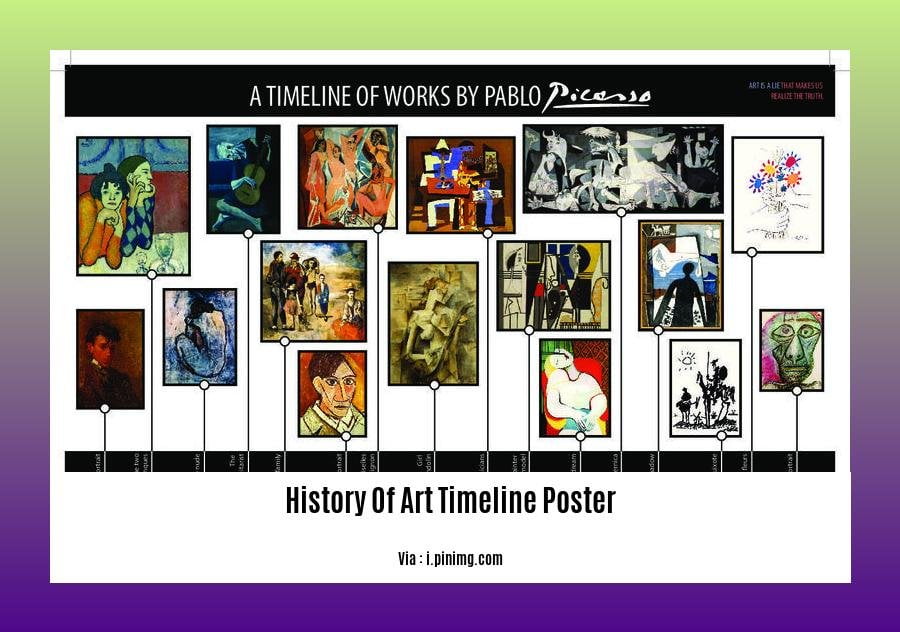
Key Takeaways:
- Visual History: Art timeline posters offer a visual representation of art history, showcasing renowned artworks from different periods and highlighting artistic evolution.
- Teaching Tool: Originating as educational resources in the late 19th century, these posters remain valuable tools for art educators in classrooms and studios worldwide.
- Historical Context: Art timeline posters include artist names, artwork titles, dates, and art movements, providing historical context for each artwork.
- Artistic Inspiration: By exposing viewers to a diverse range of art, these posters promote creativity and artistic development.
- Educational Influence: Art timeline posters in schools and museums enhance art education, allowing students and visitors to explore art history in an engaging and accessible way.
How do art timeline posters influence education in schools and museums?
Art has the power to educate, inspire, and transform lives. It is a universal language that can transcend cultural and linguistic barriers, fostering a sense of connection and understanding among people from all walks of life. Here’s how art timeline posters contribute to educational influence:
1. Visual Storytelling: Art timeline posters are like visual stories that chronicle the evolution of art through the ages. They present a chronological arrangement of artworks, allowing viewers to trace the development of artistic styles, techniques, and themes over time.
2. Historical Context: Beyond the artworks themselves, art timeline posters provide historical context, including artist names, artwork titles, dates of creation, and artistic movements. This information helps viewers understand the influences and significance of each artwork, situating it within its historical and cultural framework.
3. Comparative Analysis: By displaying artworks from different eras side-by-side, art timeline posters facilitate comparative analysis. Viewers can compare similarities and differences in artistic styles, techniques, and subject matter, fostering critical thinking and visual literacy skills.
4. Creative Inspiration: Art timeline posters are a source of inspiration for students and art enthusiasts alike. By exposing viewers to a diverse range of artistic expressions, these posters stimulate creativity and imagination, encouraging them to explore their own artistic potential.
5. Museum Learning: In museums, art timeline posters provide a valuable educational tool for visitors. They offer a concise overview of art history, helping visitors navigate the museum’s collection and understand the evolution of art over time.
In conclusion, art timeline posters are powerful educational tools that bring art history to life, fostering a deeper appreciation and understanding of art’s diverse forms and expressions. Whether in schools or museums, art timeline posters play a vital role in shaping the minds and hearts of learners of all ages.
Sources:
The Contribution of Art Museums to Art Education
Art Timeline Posters: A Visual Journey Through Art History
20th-Century Innovations: The Rise of Digital and Multimedia Formats
In the realm of art, the 20th century marked a turning point with the advent of digital technologies that revolutionized artistic expression. This revolution was characterized by the rise of digital art, a relatively new art form that harnessed the power of digital tools and techniques to create groundbreaking works of art.
The Birth of EAT: A Catalyst for Collaboration
In 1967, a groundbreaking collective called EAT (Experiments in Art and Technology) emerged, fostering collaboration between visionary artists and engineers. This alliance paved the way for the exploration of artistic possibilities offered by novel technologies, such as television monitors and computers.
Digital Frontiers: Transforming the Art World
Pioneering artists of the 1960s and 1970s embraced these new technologies, pushing the boundaries of traditional art forms. They harnessed the potential of digital tools to create dynamic and interactive artworks, challenging conventional notions of artistic creation.
The Internet’s Transformative Impact
The late 20th century witnessed the rise of the internet, which revolutionized communication and information dissemination. This technological marvel connected people and cultures worldwide, transforming the way art was created, shared, and experienced.
Key Takeaways:
- Digital Art’s Genesis: Digital art emerged in the 20th century, driven by the advent of digital technologies and the desire to explore new artistic possibilities.
- EAT’s Collaborative Spirit: In 1967, EAT (Experiments in Art and Technology) was formed to foster collaboration between artists and engineers, facilitating the exploration of art’s digital frontiers.
- Technological Embraces: Artists of the 1960s and 1970s embraced digital technologies, creating dynamic and interactive artworks that challenged traditional artistic norms.
- The Internet’s Revolution: The internet’s emergence in the late 20th century transformed art creation, sharing, and appreciation, connecting artists and audiences globally.
Sources:
[1] The Art Story: Digital Art
[2] ResearchGate: The Rise of Digital Art
Contemporary Trends: Exploring Interactive Online Platforms and Installations
Key Takeaways:
Digital interactive installations combine physical space with mixed-media compositions.
They engage viewers with responsive elements, creating immersive experiences.
Interactive art often reflects the use of extended reality technologies.
The combination of digital and traditional art forms is a growing trend in contemporary art.
Online experiences are increasingly becoming a part of contemporary art.
The integration of digital technologies and interactive elements in contemporary art has led to a fascinating evolution of artistic expression. Contemporary Trends: Exploring Interactive Online Platforms and Installations examines this innovative approach to creating immersive experiences for viewers.
Digital Installations that Engage:
Digital installations often feature responsive components that react to the viewer’s movement, touch, or sound. This interaction enhances the artistic experience, allowing the audience to become an active participant in the artwork. Artists utilize a plethora of technologies, including sensors, software, and computer algorithms, to create dynamic, immersive environments.
Extended Reality’s Role:
Extended reality technologies such as virtual reality (VR), augmented reality (AR), and mixed reality (MR) provide new avenues for artistic expression. These immersive technologies transport viewers into digital environments, allowing them to experience art in a multidimensional and interactive way.
Blending Digital and Real:
The convergence of digital and traditional art forms offers boundless opportunities for artistic creation. Artists seamlessly merge physical elements and digital projections, creating immersive installations that challenge conventional notions of art. This combination of the tangible and the digital invites viewers to navigate and explore the artwork on multiple levels.
Online Portals for Art:
The internet has opened up new frontiers for contemporary art. Online platforms and virtual galleries have emerged as significant venues for artists to share their interactive installations with a global audience. These platforms provide an accessible and engaging alternative to traditional art spaces, offering a unique and interactive experience for art enthusiasts.
A Digital Path Forward:
The integration of interactive and digital elements in contemporary art reflects a dynamic evolution that challenges traditional artistic boundaries. Artists utilize these technologies to create immersive experiences that engage viewers and explore new dimensions of art. The merging of digital and physical realms opens up exciting possibilities for artistic expression and viewer engagement, shaping the future of contemporary art.
Relevant URL Sources:
Interactive Art as Reflective Experience: Imagineers and UltraModernity
FAQ
Q1: What are the benefits of using a history of art timeline poster?
A1: History of art timeline posters offer several benefits, including providing a visual representation of the evolution of art movements, helping students and art enthusiasts understand the sequence and relationships between different artistic periods, and serving as a valuable resource for art history research and education.
Q2: What are some key elements typically included in a history of art timeline poster?
A2: Key elements commonly found in history of art timeline posters include a timeline with dates and periods, representative images or artwork from different art movements, brief descriptions or labels for each movement or artist, and sometimes additional information such as the names of influential artists or cultural context.
Q3: What are some different types or styles of history of art timeline posters available?
A3: There are various types of history of art timeline posters, ranging from simple and educational posters suitable for classrooms or study spaces to more elaborate and visually engaging posters designed for display in galleries or museums. Some posters focus on a specific period or movement in art history, while others provide a comprehensive overview of different eras and styles.
Q4: How can a history of art timeline poster be used effectively in an educational setting?
A4: In an educational setting, history of art timeline posters can be a valuable tool for teachers and students. They can be used as a visual aid to introduce or reinforce concepts related to art history, as a starting point for discussions or research projects, or as a reference guide for students to explore different artistic periods and movements.
Q5: Where can I find high-quality history of art timeline posters?
A5: There are several places where you can find high-quality history of art timeline posters. Many museums, galleries, and educational institutions offer posters for sale in their gift shops or online stores. Additionally, there are specialized art publishers and online retailers that offer a wide variety of history of art timeline posters, both in print and digital formats.
- China II Review: Delicious Food & Speedy Service - April 17, 2025
- Understand Virginia’s Flag: History & Debate - April 17, 2025
- Explore Long Island’s Map: Unique Regions & Insights - April 17, 2025
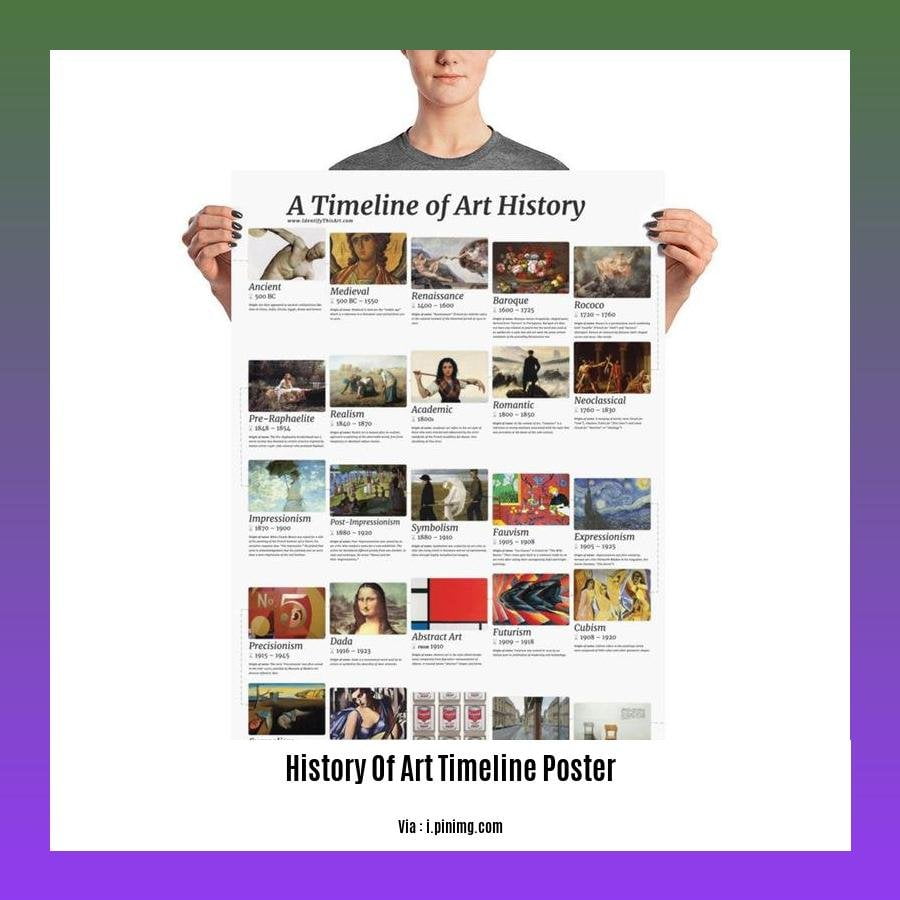
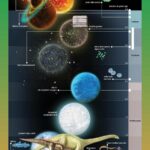
![[Phrase Match] Embracing Evolution: A Journey Through Contemporary Dance History contemporary-dance-history_2](https://www.lolaapp.com/wp-content/uploads/2023/12/contemporary-dance-history_2-150x150.jpg)


